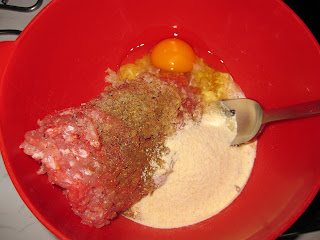When people think of Spanish food, one of the first thing that comes to their minds is probably the Paella. It's become synonymous with beach, sun and fiesta on the Spanish coast. However, I believe that the majority who have eaten paella in Spain has never eaten it properly prepared homemade style, but have been subjected to quickly heated, pre-cooked rice mix that comes from a frozen bag and added a couple of prawns for decoration. In fact, paella, which comes from the Valencia region in Spain, has many different varieties according to what has been added. I'm making a paella mixta, which combines seafood and chicken. Others use rabbit, seafood or vegetables only. Paella is more a way of cooking the rice than any final list of ingredients so feel free to improvise. I'm using my girlfriend's method, which she learnt from her mother.
Ingredients:
2 squids
1 glass of white wine
1/2 kg of fresh mussels, cleaned
1/2 kg of clams
1/2 kg of fresh prawns with shell and head
1 l. of fish/seafood stock
1 green pepper
1 onion
1-2 cloves of garlic
1/2 kg of chicken (upper thighs and drumsticks cut into smaller pieces, wings)
1 -2 tsp of sweet paprika
1 pinch of saffron
3/4 kg of round paella rice, preferably Arroz Bomba from Valencia
Salt to taste
Olive oil for frying
Lemon
Green olives
Start by cleaning the squids, remove the heads, pull out and throw away the guts and the plastic-like bone it has. Peel off the skin and cut the head off just above the tentacles. Cut the body into rings, leave the tentacles whole or half them.
Bring the white wine to a boil and steam the cleaned mussels in it under a lid for about 3 minutes. Shake the pot now and then so they move around. Discard any that hasn't opened. Remove the mussels, but keep the liquid.
Steam the clams in the liquid from the mussels. According to my mother-in-law, it's best to do the clams and mussels in separate batches, in case one mussel is bad or full of sand. Then you won't spoil the liquid from the mussels. However, I am a bit lazy and in my case they were more boiled than steamed. Again, any that hasn't opened after 3 minutes should be thrown away. Remove clams and keep the liquid. This seafood stock is the real secret to a great paella. Add the extra litre of stock. Remove the heads from the prawns and let them simmer in the stock at low heat while preparing the next step.
First, turn your oven on at 180º. Then finely chop the onion and the green pepper. Fry in a bit of olive oil until the onion is translucent. Then add the chopped or minced garlic. Add the chicken pieces and fry until brown.
Add the prepared squid and the prawns, fry for a couple of minutes, then remove prawns. Add a the paprika.
Put the pinch of saffron in a tbsp of the hot seafood stock. Let it soak for a minute before adding it to the pan.
Add the rice and let it fry for 4-5 minutes with the rest of the ingredients before adding the stock. Just remember to keep stirring it so it doesn't stick and burn. Add the simmering stock until the rice is just covered. It's important that the stock is simmering hot. The rice shouldn't be cooled down once they start cooking. Traditionally, paella is made in a flat pan over an open fire or gas burner. I have neither, so I like to finish mine off in the hot oven. That way I compensate for the deeper pan by adding heat from all directions. A little more stock may need to be added depending on the type of rice you use.
When the rice is almost cooked through, take it out of the oven, cover it and let it finish cooking by itself for a few more minutes. The rice should be tender, not mushy nor hard at the centre. The individual grains should be loose, but it's OK if there is leftover liquid. The paella will be what is called slightly 'caldosa'.
Stir in the clams and some of the mussels and prawns. Use the rest to decorate along with some green olives (you can also choose to cook the olives with the paella). Serve with a slice of lemon on the side. Buen aprovecho.





















































